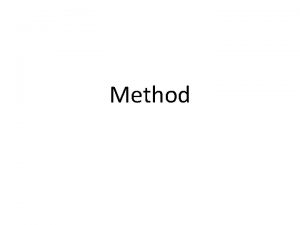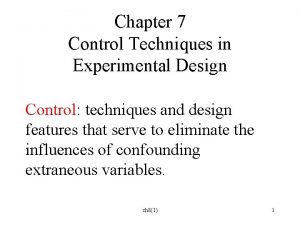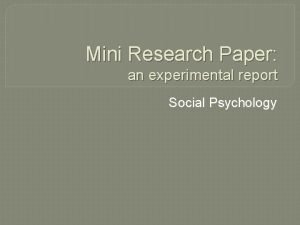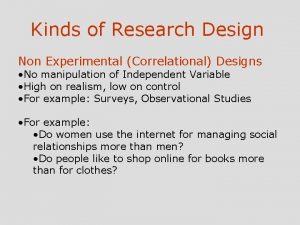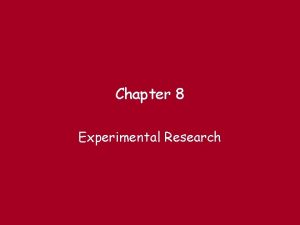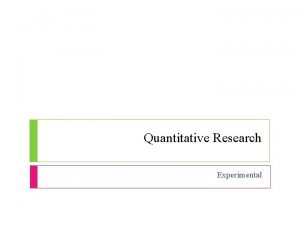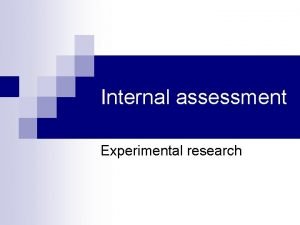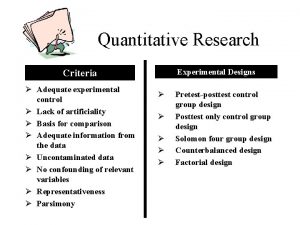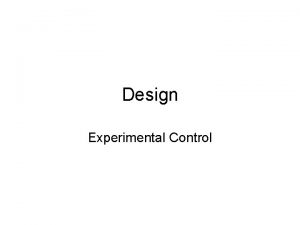Experimental Control Part 1 Experimental Control The Research















- Slides: 15

Experimental Control

Part 1 Experimental Control

The Research Cycle Real World Abstraction *** Methodology Generalization Research Conclusions Research Representation Data Analysis 1. Observational 2. Survey 3. Experimental Research Results

Observation Research Approaches Scientist as Observer Naturalistic l Observation o r t n is o C Ax Laboratory Setting Axis Role Axis True Experiment Field Setting Scientist as Participant

Experimental Control 1. Potential Pop Quiz Question: Identify the three conditions needed to make a causal inference. 2. Potential Pop Quiz Question: In your own words, explain how confounding variables are relevant to the issue of internal validity. 3. Potential Pop Quiz Question: In your own words, explain what is meant by an independent groups design.

Experimental Control 1. To say that one variable causes another, we must eliminate plausible alternative explanations. 2. Remember, the burden of proof is on the researcher, not the critics. 3. Two techniques for eliminating alternative explanations are (1) holding conditions constant, and (2) balancing. 4. Holding conditions constant - a factor that remains the same across experimental conditions cannot be the cause of any effects that are observed.

Experimental Control 1. Whenever possible, we want to hold conditions constant across different IVs (if we have more than one), and across the different levels of each IV. 2. Will someone remind us of the distinction between having multiple independent variables, and having multiple levels of an independent variable? 3. Note: It may be impossible to hold all conditions constant; We do not need to hold irrelevant factors constant (e. g. , room temperature variations of a few degrees probably don’t affect memory).

Experimental Control 1. When we can’t hold factors constant, we resort to balancing - evenly distributing the uncontrollable variations across all experimental conditions. 2. The most important factors that cannot be held constant in psychological research are participant variables. Examples? 3. Although we can’t control participant variables, we can balance them…

Experimental Control 1. Random Assignment - a procedure by which each participant has an equal probability of being assigned to each different experimental condition. 2. Could someone distinguish random assignment from random selection? 3. If there were two conditions in an experiment, random assignment could be accomplished by a coin flip for each participant. 4. Excel can simulate a coin flip, and even the flip of a “multisided” coin if we are interested in more than two conditions.

Experimental Control 1. Block Randomization - a procedure for random assignment requiring that each experimental condition has received one participant (or one observation) before any experimental condition has received a second participant (or a second observation). 2. Here’s a schematic of a block-randomized experiment…

Experimental Control Block Randomization For One Block: One Block of Conditions Random Order of Conditions ABC CBA A block is a complete set of all experimental conditions

Experimental Control Block Randomization For Multiple Blocks One Block of Conditions Random Order of Conditions ABC CBA BCA ABC ACB BAC CAB A block is a complete set of all experimental conditions

Experimental Control 1. Block Randomization has two main advantages over a pure random assignment… 2. First, block randomization ensures that there is an equal number of participants in each experimental condition. So, statistical power remains constant. 3. Second, block randomization automatically controls for time-related variables (such as fatigue or practice effects in within-subjects designs, or an “early bird” effect for between subject designs). 4. Early bird effect - Participants who volunteer early in the semester might be systematically different (e. g. , in motivation, or conscientiousness) from those who let things go to the last minute. 5. Block randomization can control for “time-of-year” effects.

Experimental Control 1. Placebo – A substance or condition that has no effect, and is used to control demand characteristics (from the participant). 2. Double-Blind Procedure – A procedure in which the participants and the data-collectors don’t know who has received which level of the independent variable. This controls for demand characteristics (from participants) and expectancy effects (from researchers).

 Experimental vs non experimental research
Experimental vs non experimental research Research paradigm example
Research paradigm example Research instrument in experimental research
Research instrument in experimental research Konstansi
Konstansi Matching by holding variables constant
Matching by holding variables constant Experimental vs non experimental
Experimental vs non experimental Cross-sectional correlational design
Cross-sectional correlational design Experimental vs nonexperimental research
Experimental vs nonexperimental research Experimental vs non experimental
Experimental vs non experimental Solomon four group design
Solomon four group design Example of experiment research
Example of experiment research Quasi experiment advantages and disadvantages
Quasi experiment advantages and disadvantages Experimental research chapter 2
Experimental research chapter 2 Experimental research report
Experimental research report Non-experimental/ descriptive design
Non-experimental/ descriptive design Random assignment vs selection
Random assignment vs selection


